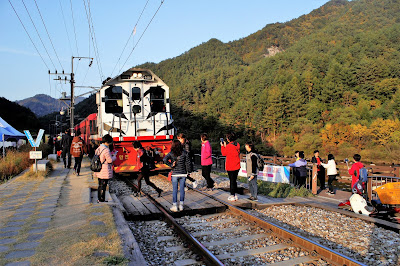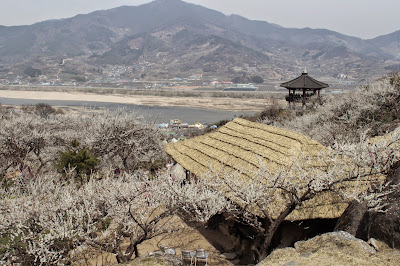If you want to be surrounded by Mother Nature of Gangwon-do, to visit here with V-train is recommended !
Gangwon-do, which all Koreans love and located in the east of Seoul, is all proud of the clean air and beautiful natural scenery. However, it would be an accurate expression to interpret the fact that clean air, if expressed otherwise, implies that traffic is inconvenient. It took a long distance by train from Seoul. We chose to Cheoram station as the starting point to ride the V-train starting from Cheoram station or Buncheon station. Going far to get on that V-train? Sure, it was. You will find out, if you have an experience, it is worthy.
Travel tips;
Most Koreans choose packages offered by day trips or two-day trips, which also visit nearby sightseeing spots because it would be very tight if someone tries to do it all in one day using public transportation in personal. This place is in a quiet far remote place from Seoul, and there is not much public transportation. This is a very popular train trip to Koreans, so there are many travel agencies in Korea that deal with these packages, but most of them are shown in Korean only, so it seems that there are many difficulties to be explained in English. For more information, visit Korailtour.com or call 1544-4590/ send email.
Cheoram is a coal mine area that was great in the past 1940s and 1960s. Now it ends its use. Coal mine history village near the station shows the story of that time, I could also enjoy a part of the old coal mine town on a passing train. This tourist train is always popular and mostly fully booked, we chose weekday tourist train so we did not have a lot of difficulties to make a reservation, but on weekends the train will be sold out as soon as it was opened a month before the reservation as I heard. It is recommended to use weekdays. We did not want to miss the autumn foliage, so we made a reservation nearly a month ago.
The train has only three carriages and the interior is decorated with retro style and it consists of a total of 158 seats, which is a main factor that is not able to supply the fulfill those needs. It runs only 2 times a day on the weekday and 3 times a day on the weekend per each direction. The locomotives dragging the three carriages is drawn tiger stripe on a white background, nicknamed the "baby white tiger train." Once upon a time, the lots of tigers lived this rugged mountain that they had expressed the concept on the train. In summer, a fan is a substitute for air conditioner. In winter, stove using with charcoal for firewood is used to warm inside carriage as the heater for heating equipment. It is a scenery that is difficult to see these days. It is fully analogue system. It is made of glass on three sides except the roof, so we could drink fresh air through opened window from the beginning to the end and it was possible to also adjust the height of the windows. There were luminescent stickers on the ceiling, all the people sang along and yelled out a cheer just like to be in the club thanks to its' sparkling stickers together with some exciting popular song when on passing several tunnels.
It did not take so long time till to admire the spectacular scenic views spread out along the remote mountainous valley train runs. The whole mountain wearing in yellow and red color greeted me. I was so happy for my luck to see the wonderful leaves at one time that I could appreciate for a lifetime. Because of the air that is quite much fresher from the city, the color of the fall foliage looked more transparent than one of the city. According to the friend who boarded it before, the azalea filled the whole mountains in spring, and the mountains covered with white snow in winter shows upscale view like Oriental painting different from those in the city. The best choice of this train trip is said to be used in winter. The V-train run between Cheoram and Bucheon which is the narrow gorges where steep cliffs and rocky mountains are in Gangwon-do and brought me to a difficult place to get to if it is not a train. The section is 28 kilometers long, 30 kilometers per hour, so you can enjoy panoramic view of about an hour. We got off the train two times at Shengbu Station and Yangnuan Station. In these slow-moving tiny stations, people moved slowly and a little old-fashioned vibe enough to invoke nostalgia. We took photos and bought local products and food even though for a short stopover time and took it to the car and enjoyed it. The Yangwon station, which was the smallest train station in Korea, was so small that you’re not able to recognize it unless you look closely. The cosmos blooms next to the railroad added a taste of fall. One bright yellow ginkgo tree beside the railroad seemed like to be writing the story of the fall. The destination station, Buncheon station, has set up sisterhood relationship with Zermatt station in Switzerland. It is a heavy snowy area in the winter, so they set up Santa village and greeted travelers with diverse event during winter season. We met Santa Claus and deer in the fall.













































.JPG)


.JPG)






